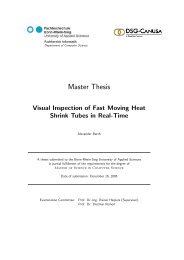Master Thesis - Hochschule Bonn-Rhein-Sieg
Master Thesis - Hochschule Bonn-Rhein-Sieg
Master Thesis - Hochschule Bonn-Rhein-Sieg
You also want an ePaper? Increase the reach of your titles
YUMPU automatically turns print PDFs into web optimized ePapers that Google loves.
6. Evaluating the safety <strong>Master</strong> <strong>Thesis</strong> Björn Ostermann page 103 of 126<br />
Type B:<br />
This standard contains a concept that can be used to reach the goals for the risk assessment which<br />
is required according to the general principles of annex I of the Machinery Directive respectively<br />
by EN 12100-1.<br />
- EN 999 “Safety of machinery — The positioning of protective equipment in respect of approach<br />
speeds of parts of the human body”<br />
This standard “provides parameters based on values for hand/arm and approach speeds and the<br />
methodology to determine the minimum distances from specific sensing or actuating devices of<br />
protective equipment to a danger zone” [69].<br />
- EN ISO 13857 “Safety of machinery — Safety distances to prevent hazard zones being reached<br />
by upper and lower limbs”<br />
This standard gives distances that have to be kept between hazardous areas and openings in<br />
protective devices. Those values are designed to fit 95% of the population.<br />
- EN ISO 13849-1 “Safety of machinery — Safety-related parts of control systems — Part 1:<br />
General principles for design”<br />
Type C:<br />
This standard “provides safety requirements and guidance on the principles for the design and<br />
integration of safety-related parts of control systems” [72]. It covers the determination of the<br />
required performance level that a control has to achieve for a specific task and the evaluation of<br />
the performance level the given control is achieving.<br />
- EN ISO 10218-1 “Robots for Industrial Environment — Safety requirements — Part 1:Robot”<br />
This standard “specifies requirements and guidelines for the inherent safe design, protective<br />
measures and information for use of industrial robots […]. It describes basic hazards associated<br />
with robots, and provides requirements to eliminate or adequately reduce the risks associated<br />
with these hazards.” [70]<br />
The type A standards are too general to be applied in the course of this thesis.<br />
The type B and C standards are explained further in the following chapters.<br />
6.2.1 Safety of machinery – Safety distances to prevent hazard zones being<br />
reached by upper and lower limbs<br />
EN ISO 13857:2008 (EN 294:1992)<br />
This standard [73] is on safety distances to prevent humans from reaching harmful objects.<br />
In this project an offset had to be chosen for the measured distance values, in order to decrease the<br />
amount of fluctuation noise (see chapter 4.3.3). This offset needed to be as large as possible, while still<br />
allowing intruding objects to be recognized.














